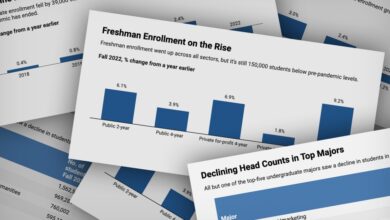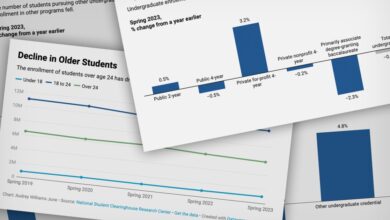4 Emerging Trends You Should Know About


Mark Harris for The Chronicle, photos from iStock
When Harvard College’s admissions policy was dissected in court, in 2018, the whole world was able to scrutinize the methods and criteria its officers use to admit students. Although the trial concerned race-conscious admissions, it returned one admissions practice, common among selective colleges but highly unpopular among Americans, to the spotlight: legacy preferences.
Harvard admissions officials testified that qualified children of alumni get a “tip,” or boost, during the application process. While the overall acceptance rate to the college has been in the single digits for years, documents filed by the plaintiffs appeared to show that about 33 percent of legacy applicants were accepted for admission to the Classes of 2014 through 2019. Op-eds urging the end of legacy preferences followed, along with predictions that the practice might not last.
That pressure has continued to grow. Last year more than 1,000 people signed a pledge promising not to give money to their colleges until legacy status was dropped from admissions decisions. The state of Colorado banned legacy preferences at its public colleges. Amherst College announced that legacies, who had made up 11 percent of incoming students, would no longer be given a preference.
Those changes followed the disclosure, in early 2020, by the Johns Hopkins University that since 2014 it had been quietly doing away with legacy preferences. In 2019 the new freshman class included just 3.5 percent legacies, down from 12.5 percent in 2009. Johns Hopkins administrators said that there had been “some” pushback from alumni and members of the Board of Trustees, but just as many alumni had said they supported the change. It seemed as if legacy admissions might become a thing of the past.
Though change has been slow, it may be gathering steam. So far, Harvard does not seem to have abandoned the practice. But this month, Rep. Jamaal Bowman and Sen. Jeff Merkley introduced federal legislation that would prohibit colleges from giving admissions preferences to applicants with legacy or donor status.
Institutions like Johns Hopkins and Amherst want to erase the perception that they are giving already-privileged students yet another advantage in the admissions process. They join others, including the University of California system, the University of Georgia, the Massachusetts Institute of Technology, and the California Institute of Technology, that have not considered their applicants’ legacy status for many years.
Some observers reject the idea that getting rid of legacy preferences will do much to diversify colleges’ student bodies.
“That alone, given the racial inequality in America, is not going to eliminate racial inequality on campuses,” says Natasha Warikoo, a sociology professor at Tufts University. If Amherst’s freshman class is roughly 500 students (the college enrolls 1,970 students in total, according to its website), eliminating legacy freshmen — which the college probably won’t do entirely, since some may still get in — would free up only about 55 spots. In Colorado, public colleges reportedly were already ignoring legacy status when admitting students. Even if the number of new spots available were larger, eliminating legacy preferences wouldn’t change the fact that the children of the graduates of selective colleges are likely to continue to have resources, such as access to tutors, counselors, and wealthy school districts, that give them an advantage in the admissions process.
But even if dropping the practice is mostly about perception, Warikoo says, that doesn’t mean it’s a bad idea. “Legacy admissions doesn’t play a huge role, but it plays a symbolic role.”
Johns Hopkins officials acknowledged as much. Back in 2020, they said that ending legacy preferences was one of several changes that had helped the institution diversify its enrollment. It was important to end the practice to send the message to underrepresented students that the university wanted them, even if they lacked relatives who had attended.
The pressure on colleges that still consider legacy status will probably continue at a low hum. But as more do away with the practice, keeping it may feel increasingly antiquated and unfair. —Nell Gluckman

Mark Harris for The Chronicle, photos from iStock
Examine Northeastern University’s footprint, and you’ll find that it extends far beyond the Northeast. The private research university in Boston has campuses not just in nearby Portland, Me., but also in North Carolina, Seattle, Toronto, and even London.
But its latest move, the acquisition of Mills College, in Oakland, Calif., may be a telling sign of how financially stable campuses approach expansion as the pandemic enters its third year. Mills is now Mills College at Northeastern University and the Mills Institute, focused on women’s leadership, students of color, and first-generation college students. In turn, Northeastern’s West Coast flag is planted even more firmly.
While recent decades have seen international and domestic expansion, colleges’ divergent financial prospects during the pandemic have created new opportunities for acquisitions, mergers, and takeovers, some of them far beyond campuses’ traditional turf. The deals will bring complexity — integrating campus cultures takes coordination and care — and raise the possibility of layoffs or other restructuring.
Robert Kelchen, a professor of higher education at the University of Tennessee at Knoxville, says colleges with money see opportunities to expand as smaller, financially weaker institutions face uncertainty. Covid-19 has widened financial divisions between colleges, and that could spark new interest in acquisitions and mergers.
Expect public and private colleges to pursue those efforts differently, he says. Private campuses will seek to acquire colleges in desirable locations — either because they are in high-growth areas or because they offer nearby property. Public colleges will seek underserved markets, including online students or more remote areas of the state. In some cases, state-university systems may try to grow.
“At the start of the pandemic, our leadership team doubled down on their desire to expand, knowing that the higher-ed model of learners coming to us needed to change,” says Mary Ludden, Northeastern’s senior vice chancellor overseeing the university’s global campus network. “We needed to be more where the learners are, where industry is, where partners are, where government is.”
Why now? For high-endowment colleges, finances are surprisingly strong, with robust investment returns and stable state funding, Kelchen says. Financially weaker colleges are feeling sharp stress.
“They are very resilient,” he says. “They don’t want to close. But at the same time, they may be more interested in looking for opportunities to at least preserve some of their legacy.”
Even less-wealthy institutions are seeing opportunities with smaller colleges. Emerson College in 2020 completed the acquisition of Vermont’s Marlboro College, creating the Marlboro Institute for Liberal Arts and Interdisciplinary Studies at Emerson College. Though plans for the move took shape before the pandemic, such a step will make intuitive sense for more institutions, says Paul Dworkis, Emerson’s vice president for administration and finance.
Dworkis says he expects similar deals to occur as smaller, tuition-dependent colleges’ prospects for growth dim. “I don’t think the long-term trajectory has changed for institutions,” he says. “The smaller schools are always the ones that are the most vulnerable.” —Lindsay Ellis

Mark Harris for The Chronicle, photos from iStock.
College and university endowments enjoyed a historically prosperous year in 2020-21, generating billions of dollars for their institutions. At Harvard University, long home to the largest academic endowment in the world, the fund’s total value rose to $53.2 billion, riding a 33.6-percent return. Yale University’s endowment fared even better, posting a return of 40.2 percent. But neither could compete with Washington University in St. Louis, which saw a return on its endowment of 65 percent. At the end of the 2021 fiscal year, its endowment sat at $15.3 billion.
Sectorwide results are due out this month, but those eye-popping individual gains are raising expectations that the overall results will look markedly different from the recent past. In the 2019 fiscal year, academe eked out only a 5.3-percent average endowment return, according to an annual analysis by TIAA and the National Association of College and University Business Officers.
This new surge of wealth, recorded before the recent market gyrations, follows a period when some of higher ed’s deepest-pocketed institutions have been under heightened scrutiny. Even before the pandemic, the richest colleges faced a tax on their endowment earnings. And when campuses cut back because of the pandemic, in 2020, disgruntled students and employees questioned why those vast pools of endowment-generated income couldn’t be used to cushion the blow.
Administrators’ customary response has been to distinguish “restricted” from “unrestricted” designations in endowed funds: Many gifts to endowments are contractually reserved for specified uses and no other. While those explanations are often true, their implicit assumption — that leaders should stick with business-as-usual, long-term growth strategies — has seemed out of touch during an unprecedented moment.
But that may be starting to change. A number of colleges are tapping their endowment funds to better support students and employees. At the Massachusetts Institute of Technology, for example, administrators announced a plan to use its nearly 56-percent gain in endowment returns during the 2021 fiscal year to provide an estimated $286 million for graduate students, campus infrastructure, and research. With the help of its 51.5-percent endowment return and a fund-raising campaign, Brown University plans to add $25 million annually to the undergraduate financial-aid budget to fully cover tuition for students whose families earn $125,000 a year or less with typical assets. And at Smith College, President Kathleen McCartney wants to guarantee that her students never need to take out loans to attend. To do so, the college will make available an additional $7 million — derived from a combination of endowment returns, gifts to the college, and grants — to entering low-income students. McCartney says Smith’s leaders knew well which students would most benefit from the change.
“A greater percentage of students of color take out loans, and they take out more loans,” she says. “And so this aligned beautifully with our commitment to racial justice and equity.”
But colleges and universities should think carefully before adopting new policies focused on affordability, and committing endowment returns to support them, says Sandy Baum, a nonresident senior fellow at the Urban Institute. A seemingly revolutionary policy can still fail if not properly calibrated for the specific needs and lives of current and future students, Baum says. A policy of no student loans might make sense for Smith’s finances and enrollment, but a different endowment-financed initiative might be a better fit for a tuition-dependent college. Institutions should learn more about the low- and moderate-income students they admit, as well as those who go elsewhere because of an inability to pay, before taking any particular action.
“For a long time, need-based financial aid has been high on the priority list for many, many institutions,” Baum says, “and they just have really difficult trade-offs and choices to make.” —Dan Bauman

Mark Harris for The Chronicle, photos from iStock
The Covid-19 pandemic has nurtured a boom in fast, public science.
In the first 10 months of the crisis, scientists posted more than 30,000 preprints about the coronavirus online. Preprints are papers written in the standard journal format, but not yet peer-reviewed. Through October 2020, they accounted for about a quarter of Covid-related publications worldwide, according to a study in PLOS Biology. (The study itself first appeared as a preprint.) No other epidemic — including recent outbreaks of the Ebola and Zika viruses — has led to that kind of pileup. This outpouring of open science helped researchers learn and disseminate information about the coronavirus in record time. By the end of January 2020, before Covid had even been declared a pandemic, a research team had posted a preprint on how the coronavirus enters human cells. Some of the first papers to model the efficacy of frequent testing to prevent Covid outbreaks at residential colleges were preprints posted in the summer of 2020.
Researchers who study the scientific process don’t expect this high pitch to continue as the pandemic wears on, but they do anticipate that the overall number of biomedical papers first published as preprints will continue to climb. While that will be a boon for transparency and nimbleness in biology, the Covid era illustrates a serious drawback of preprints, too: the potential for misuse and misinformation.
It’s already standard practice in some fields of physics for scientists to publish their findings as preprints. Proponents hope to see the practice widely adopted in biology, epidemiology, medicine, and public health.
Structural changes that support preprinting are also afoot. MedRxiv, a preprint server dedicated to medical studies, was founded in June 2019, just in time for the coronavirus pandemic. It stands ready to host other medical preprints as the intensity of scientific interest in the coronavirus wanes. Over the last several years, some funding bodies have begun encouraging or requiring their grantees to post preprints of their funded work. In December 2020, the biology journal eLife announced it would accept only manuscripts that had first appeared as preprints.
Danger looms, however. Alongside the pandemic, the world has witnessed a crisis of misinformation about the coronavirus. By design, preprint servers allow people to post anything that has the basic components of a scientific paper, such as an abstract, methods section, and data and tables. Could biomedical preprints worsen the effects of health misinformation?
In April 2020, a preprint argued that the coronavirus’s fatality rate was extraordinarily low. Not surprisingly, it went viral. The paper suffered from many flaws and probably would have been heavily edited after peer review, Yonatan Grad, an associate professor of infectious disease at Harvard, told two journalists. But the provocative paper spread quickly among conservative influencers, who used it to argue against Covid restrictions that states had put in place at the time.
Peer review doesn’t necessarily inoculate papers against such misuse, however. Studies of hydroxychloroquine began as peer-reviewed papers that showed its ability to keep the coronavirus from multiplying in a petri dish. Unfortunately, later studies, done in people, found that hydroxychloroquine doesn’t work against Covid-19. Nevertheless, when President Donald J. Trump tweeted a link to a small, lackluster human study to tout the drug as a Covid cure, it was retweeted 300,000 times, reported Australia’s ABC News.
It’s impossible to know how many inaccurate beliefs about Covid had their roots in preprints. However, it’s clear that they’re only part of a larger misinformation ecosystem that encompasses everything from preprints to journal articles to impressive-looking homemade charts posted by people with no expertise. So solutions may have to reach deeper than preprint servers. Ivan Oransky, a physician and health journalist who founded Retraction Watch, a news site about corrections in scientific literature, suggests better early media literacy is needed.
“We used to sort of chuckle about social-media influencers’ selling expensive jewelry or whatever they were selling,” he says. “Now you have people who have taken that model and turned and used it for promoting misinformation because it sells well.” And most audiences don’t draw any distinctions. —Francie Diep
Source link







